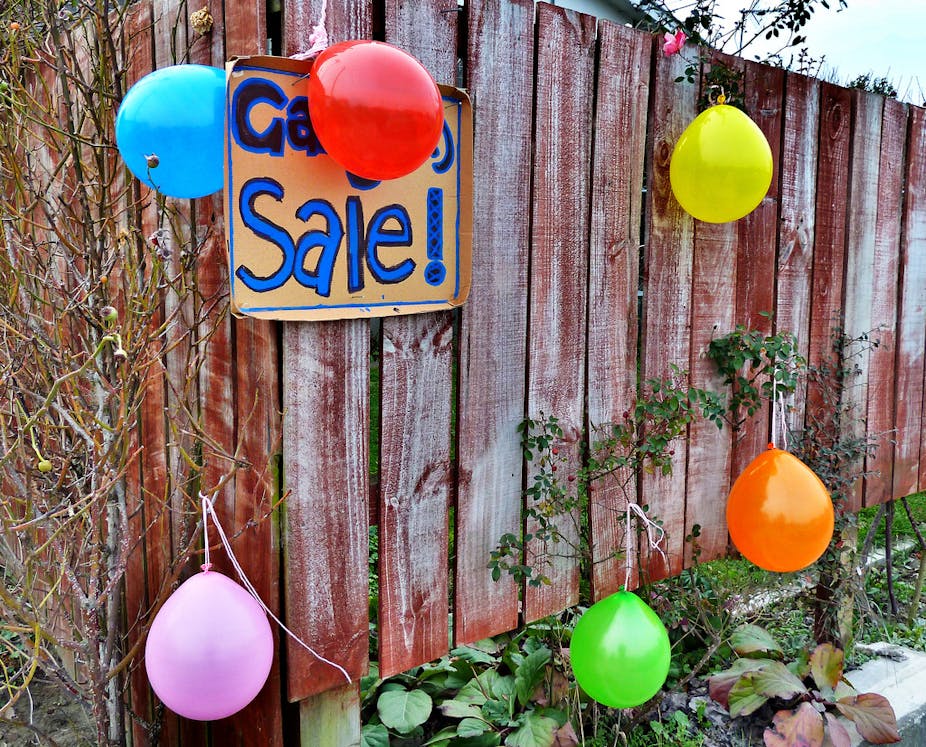Garage sales have long been a fixture of Australian suburban culture, with people selling their unwanted things in their yard or garage, usually at token or negotiable prices. In the past, sales were usually advertised locally, with signs placed on street poles or in the local paper. They were generally isolated affairs, dispersed throughout the year with little to no co-ordination between individual sales. Their potential for re-using unwanted goods was limited.
The Garage Sale Trail drags the humble garage sale into the 21st century, using online communication to boost sellers’ profile and participation.
The concept is simple enough. Garage Sale Trail is an online database of garage sales nationwide, coordinated on a single day – Saturday May 5. Users can search for what’s being sold at a particular sale, and can plan a route of sales to visit throughout the day.
Buying and selling second hand
More often than not, people use garage sales as a way to get rid of things rather than to make money. If someone really wants to get the maximum possible amount for their unwanted goods, they’re more likely to sell it somewhere like eBay, Gumtree, or Craigslist. Sites like these have a much larger market exposure, with more people bidding for each item.
The flip side is that garage sales can be a great source of a bargain. They also give us an opportunity to meet people in our local neighbourhood that we might not otherwise meet. Exchanging second hand goods locally in this way can become a community-building tradition, as is the case in some other parts of the world.
Garage sales are able to divert items that might otherwise end up in landfill. But they also mean that items are re-used locally – a sustainable practice if ever there was one.
The benefits of re-use
A significant proportion of the resources consumed in a good’s life-cycle are spent on the extraction of raw materials, production processes, and transportation to the point of sale.
However, in choosing to buy second-hand goods instead of new ones, we can make significant savings in the overall resources consumed. A life cycle assessment (LCA) of re-used clothing sourced from donations in the UK found re-use consumed only 1.8-2.6 % of the energy of producing new clothing sourced from raw materials.
Buying something second-hand means extending the life of existing objects. It eliminates the need to produce more material goods to satisfy our needs.
What are we selling – and why?
As many of this weekend’s garage sales will demonstrate, there’s certainly no shortage of “stuff” in most of our homes. Despite the rhetoric about the rising cost of living, the prices of most consumer goods are at all time lows. The combination of cheap foreign production labour, reduced tariffs, and a strong Australian dollar means that we’re fortunate enough to be able to purchase plenty of consumer durables.
However, with an abundance of consumer goods in the shops and in our homes, we find ourselves dealing with the curious phenomenon of “clutter”. Over time, we gradually accumulate things before realising that the very objects that were meant to bring us satisfaction have actually become a burden.
Books, magazines, DVDs, clothing, shoes, ornaments, souvenirs, electronics, furniture, crockery – our homes and our lives would undoubtedly be worse off without some of these things. Yet we can also clearly have too much of them. At some point, many of us feel the need to “de-clutter”, and to get rid of the things that are worn out, unfashionable, broken, obsolete, or that we no longer have a use for.
Out with the old, in with the new?
Many of the garage sales this weekend will be attempts to “de-clutter” the home. Getting rid of things in this way can be relieving for those that feel they have accumulated too many things to deal with. This is especially the case when we know that the things we’re selling to someone aren’t going to waste in landfill.
However, we need to ask ourselves if, in de-cluttering our homes, we are just making room for more “stuff”. Might we be doing a similar clean out for the Garage Sale Trail in a few years time?
Or could we actually get by with owning less? Perhaps the best way of dealing with clutter is to not let it accumulate in the first place.
The Garage Sale Trail, and its associated media exposure, is likely to be successful in promoting the local exchange of things we no longer use - a great step toward establishing a culture of re-use in our communities. It may also encourage us to think more carefully about buying things that we momentarily desire (and can easily afford) as opposed to those that we truly need, and will serve us well throughout our lives.

